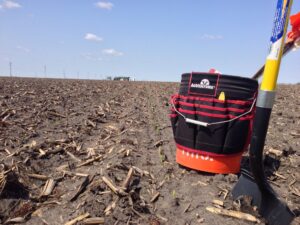This is the first of a 3-part series to familiarize yourself with the common corn seedling diseases you may encounter this spring. With most U.S. farm fields coming back to corn every other year and many being utilized in continuous corn or corn-on-corn situations, the disease spectrum waiting to feast on corn seedlings may be immense. AgVenture Security Seed Protection™ powered by LumiGEN® seed treatment packages offer the best protections available in the market today. However, here is relevant information on pesky diseases you may encounter year in and year out if you farm in the U.S.
Content by Mark Jeschke, Ph.D., Agronomy Manager, Corteva Agriscience
 A great ending has to start with a solid beginning.
A great ending has to start with a solid beginning.
Corn fields can contain numerous pathogens in the soil that are capable of infecting corn seeds and seedlings. Corn planted into a well-prepared seedbed with warm conditions that allow it to emerge quickly, can generally outgrow the effects of pathogen attack. However, corn planted into cold, wet soils that emerges more slowly can be susceptible to injury from soilborne pathogens. Soilborne pathogens may attack seeds and seedlings both before and after plant emergence, as well as the roots and mesocotyl of emerging or established plants.
The effect of soil-borne diseases on stand establishment and plant development depends largely on the duration of adverse weather and the prevalence of other factors that affect overall plant health, emergence, and early growth. Soil compaction, heavy crop residues, crusting, herbicide or fertilizer injury, and excessive planting depth can all weaken the plant, delay emergence, and increase the susceptibility of corn seedlings to diseases.
The ideal environment for most soilborne diseases that attack corn seeds and seedlings is wet and cool (50-60ºF, 10-16ºC). Under these conditions, corn develops very slowly. For example, when the soil temperature averages only 55ºF (13ºC), corn seedlings require over 20 days to emerge. Fungicide seed treatments applied at label rates to protect the seed during germination and emergence can provide protection for six weeks after planting. However, extended delays in emergence can stretch the limits of fungicide seed treatments and makes seeds vulnerable to attack. Soil temperature during emergence is determined by geography, soil type, soil moisture, residue cover, tillage, planting date and weather patterns.
Weather conditions are the most important determinant of growing environment in any year. Cold, wet conditions that favor seed and seedling disease development will occur periodically in all fields and frequently in some fields. The amount of inoculum in the soil also affects disease development. Soilborne pathogens that attack corn seedlings survive in both corn residue and in the soil. They are both saprophytic and parasitic, able to attack dead and living plant tissue. Pathogens have alternative hosts, sometimes including previous crops and weeds – both corn residue and that of other crops and weeds can be important to inoculum load. If a field has a history of seedling disease problems, inoculum load is likely to be high. Knowing the history of each field with respect to problem areas and related causes is important to successful management of seedling diseases.
Now that we’ve set the table, be looking for Part 2 in this series that will focus on major pathogens.
